Impact of Climate on the World :
"Change is the law of nature "
Climate change is one of the biggest challenges facing the world today. It is responsible for the increase in extreme weather events, as well as an unbroken series of hottest years on record. Indeed, environmental concerns and the threat posed by climate change have been a consistent feature of the World Economic Global Risks Report for the last decade.
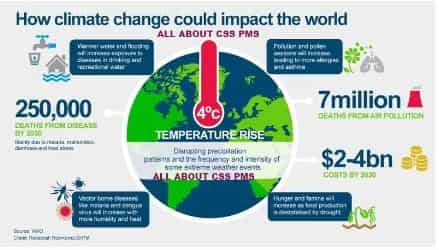
Climate Change is a reality. It has changed in past, is changing in present and will change in future. Atmosphere is always in a state of turmoil and instability leading to variation in weather and climatic conditions. Thus the variation and shifts in weather conditions over space and time of different scales and magnitude resulting into changes of Climate type is defined as Climate Change. For example, from warm and moist climate to warm and dry climate.
The rate of climatic changes depends on the nature of causal factor. This may be gradually or rapidly, partly or drastically, short term or long term, local, regional, or global scale. The Climate change which occurred during Jurassic Period leading to mass extinction of Dinosaurs due to sudden onset of Cold Climate was rapid and instantaneous.
Impacts of Climate Change :
Rising global temperature is accompanied by the changes in weather and climate like changes in rainfall, resulting in more floods, droughts, or intense rain, as well as more frequent and severe heat waves. The planet's oceans are melting, and sea levels are rising. As these changes become more pronounced in the coming decades, they poses a great challenge to our society and our environment.
High Temperatures :
- Green House gases release by power plants, automobiles, deforestation and other sources are heating up the planet. In fact, the five hottest years on record have all occurred since 1997 and the 10 hottest since 1990, including the warmest years on record - 2005 and 2010.

- Increased temperatures are to blame for an increase in heat-related deaths and illness, rising seas, increased storm intensity, and many of the other dangerous consequences of climate change.
- During the 20th century, the Earth's average temperature has increased by one degree Fahrenheit to its highest level inn the past four centuries - believed to be the fastest rise in a thousand years.
- Research found that if emissions of heat-trapping carbon emissions aren't reduced, average surface temperatures could increase by 3 to 10 degrees Fahrenheit by the end of the century.
Changing Landscapes :
- Increasing temperatures and changing patterns of rain and snow have resulted in moving of trees and plants around the world toward Polar Regions and up mountain slopes.
- These vegetation shifts will affect much of the work the conservation community has accomplished to date, with the potential to permanently change the face of conservancy preserves, local land trusts, and even our national parks.
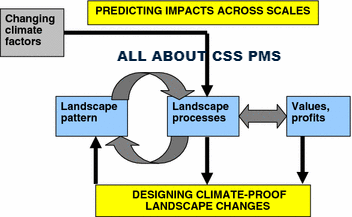
- As plant communities try to adapt the changing climate by moving toward cooler areas, the animals that depend on them will be forced to move in order to survive.
- Some species and communities such as polar bears and alpine meadows may be left without any remaining viable habitat, putting much of our treasured wildfire at risk.
Wildlife/Ecosystem at Risk :
- Increased temperatures are changing weather and vegetation patterns across the globe, forcing animal species to migrate to new, cooler areas in order to survive.
- The rapid change of climate change is likely to exceed the ability of many species to migrate or adjust. Experts predict that one-fourth of Earth's species will be headed for extinction by 2050 if the warming trend continues at its current rate.
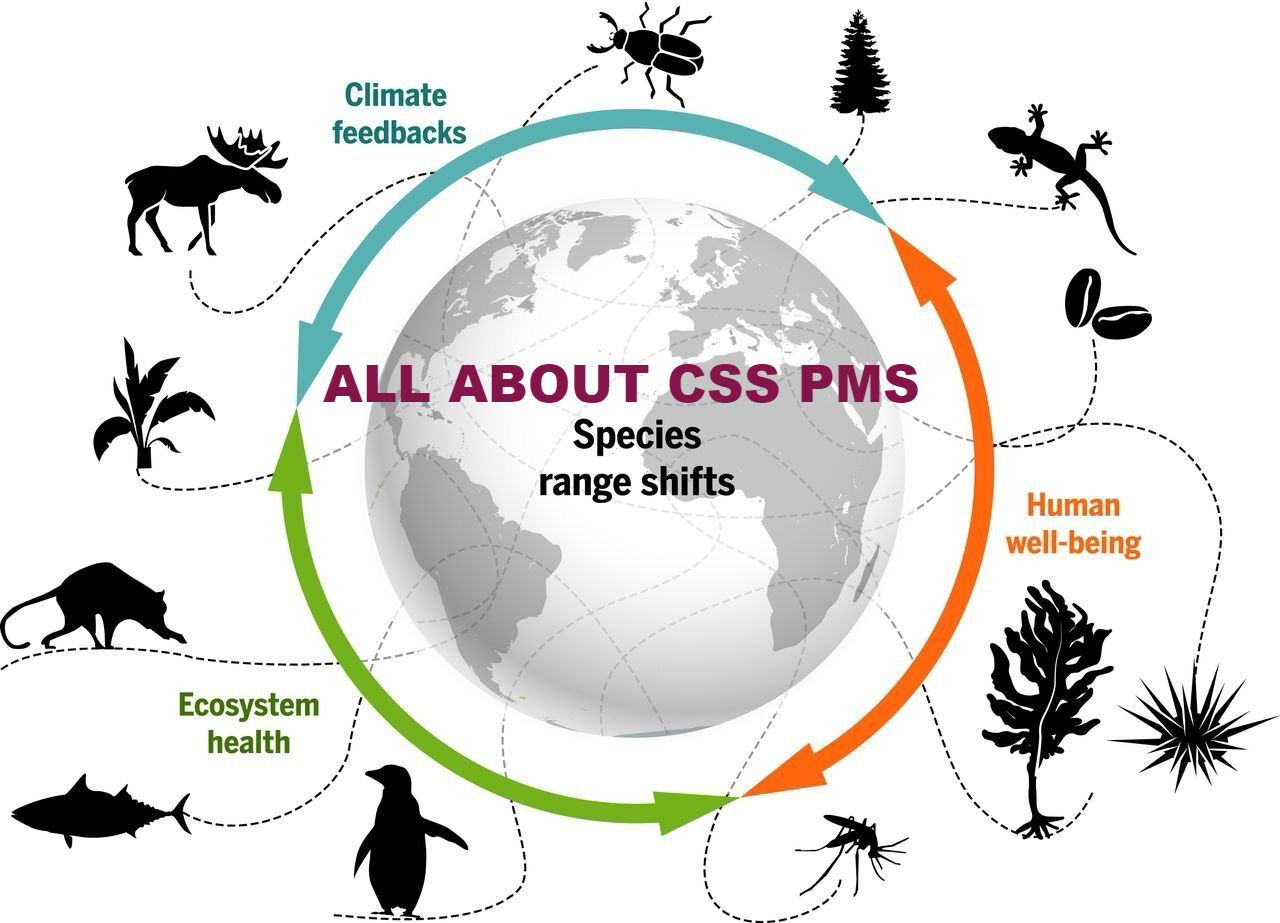
- Many species are already feeling the heat.
- In 1999, the death of the last Golden Toad in Central America marked the first documented species extinction driven by climate change.
- Due to melting ice in the Arctic , polar bears may be gone from the planet in as little as 100 years.
- In the tropics, rising the sea temperatures are causing more coral reefs to bleach as the heat kills colorful algae that are necessary to coral health and survival.
Ocean Acidification/Rising Sea level :
- As the Earth heats up, sea levels rise up because warmer water takes up more area than colder water, a process known as thermal expansion. Melting glaciers compound the problem by dumping even more fresh water into the oceans.
- Rising seas threaten the populated low-lying areas, islands and dense coastal populations, erode shorelines, damage property and destroy ecosystems such as mangroves and wetlands that protect coasts against storms.
- Sea levels have risen between four and eight inches in the past 100 years. Current projections suggest that sea levels could continue to rise between 4 inches to 36 inches over the next 100 years.
- The increased concentration of carbon dioxide (CO2) in the atmosphere has increased the absorption of CO2 in the ocean, which reduces the PH and makes the ocean more acidic.
- A more acidic ocean would adversely affect the health of many marine species, including plankton, molluses, and other shellfish. In particular, corals can be very sensitive to rising acidity, as it is difficult for them to create and maintain the skeletal structures needed for their support and protection.
Increased Risk of Drought, Fire and Floods :
- Higher temperatures increase the amount of moisture that evaporates from land and water, leading to drought in many areas. Lands affected by drought are more vulnerable to flooding once rain falls.
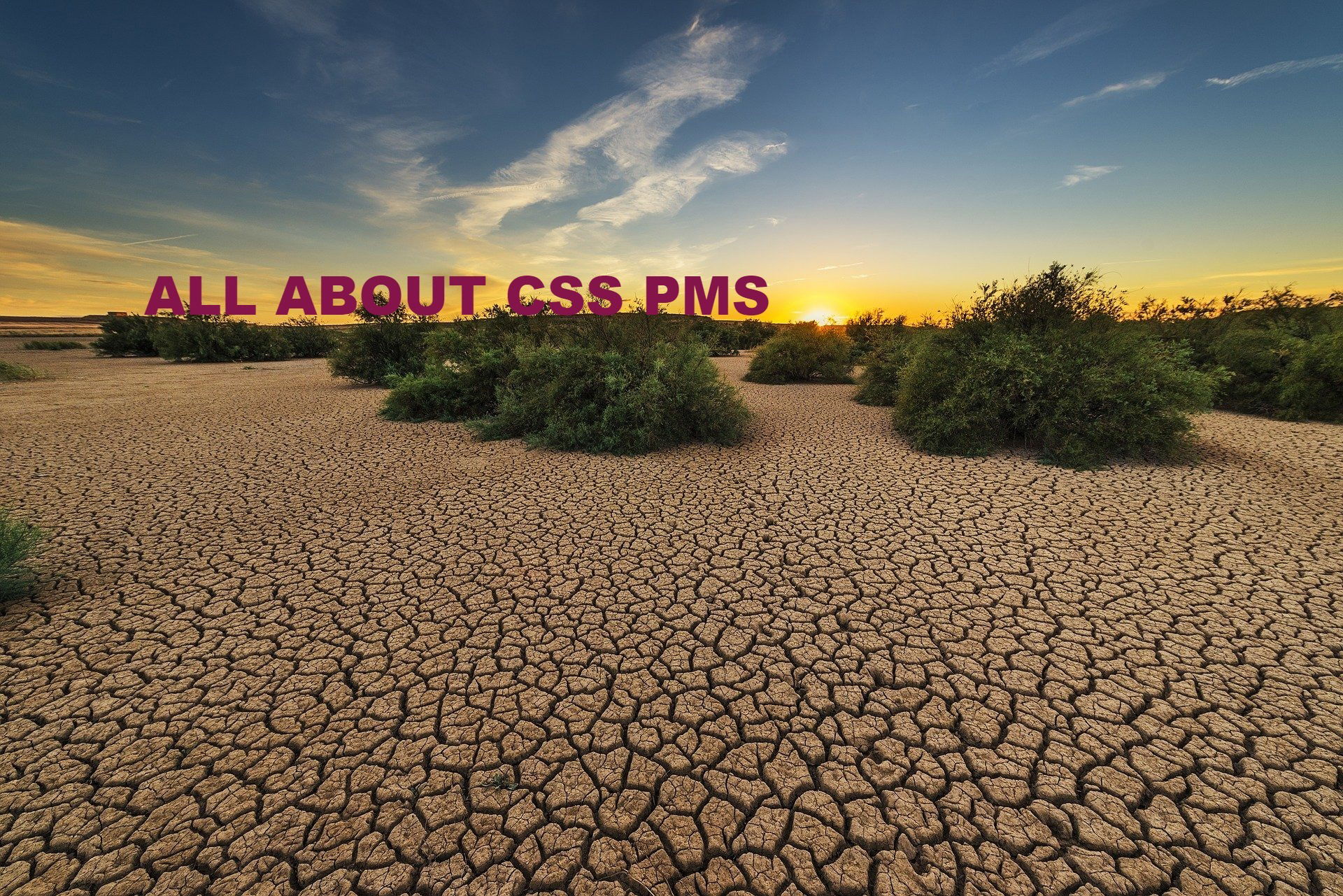
- As temperatures rise globally, droughts will become more frequent and more severe, with potentially devastating consequences for agriculture, water supply and human health. This phenomenon has already been observed in some parts of Asia and Africa, where droughts have become longer and more intense.
- Hot temperatures and dry conditions also increase the likelihood of forest fires.
Intensified Storms and Increased Storm Damages :
- Scientific research indicates that climate change will cause hurricanes and tropical storms to become more intense - lasting longer, unleashing stronger winds, and causing more damage to coastal ecosystems and communities.
- Higher ocean temperatures is the main culprit, since hurricanes and tropical storms get their energy from warm water. As sea surface temperatures rise, developing storms will contain more energy.
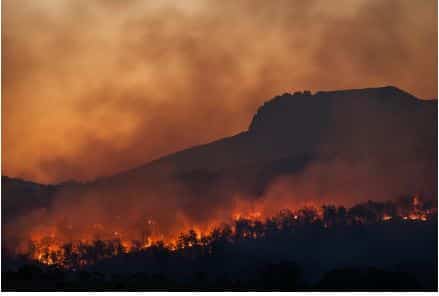
- at the same time, other factors such as rising sea levels, disappearing wetlands, and increased coastal development threaten to intensify the damage caused by hurricanes and tropical storms.
Illness and Disease :
- As temperatures increases, so do the risks of heat-related illness and even death for the most vulnerable human populations. Scientists have linked the deadly heat waves to climate change and warn of more to come.
- In 2003, for example, extreme heat waves caused more than 20,000 deaths in Europe.
- Climate change has increases the spread of infectious diseases, mainly because warmer temperatures allow disease-carrying insects, animals and microbes to survive in areas where they were once blocked by cold weather.
- Diseases and pests that were once limited to the tropics such as mosquitoes that carry malaria - may find hospitable conditions in new areas that were once too cold to support them.
- The World Health Organization (WHO) estimates that climate change may have caused more than 150,000 deaths in the year 2000 alone, with an increase in deaths likely in the future.
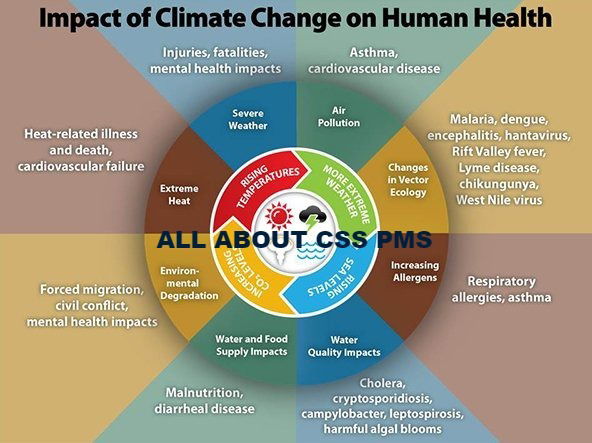
Economic Losses :
- Research says that if no action is taken to curtail the global carbon emissions, climate change could cost between 5 and 20 percent of the annual global gross domestic product. In comparison, it would take 1 percent of GDP to lessen the most damaging effects of climate change.
- Climate change may significantly lower lake levels, altering shoreline habitats and costing millions for the relocation of ports and shore infrastructure.
- Globally, more intense hurricanes and downpours could cause billions of dollars in damage to property and infrastructure.
- Declining crop yields due to prolonged drought and high temperatures, especially in Africa, could put hundreds of thousands of people at risk for starvation.
- High sea temperatures also threaten the survival of coral reefs, which generate an estimated $375 billion per year in goods and services.
Agriculture productivity/Food Security :
- Solar radiation, temperature, and precipitation are the essential drivers of crop growth; therefore agriculture has always been highly dependent on climate patterns and variations.
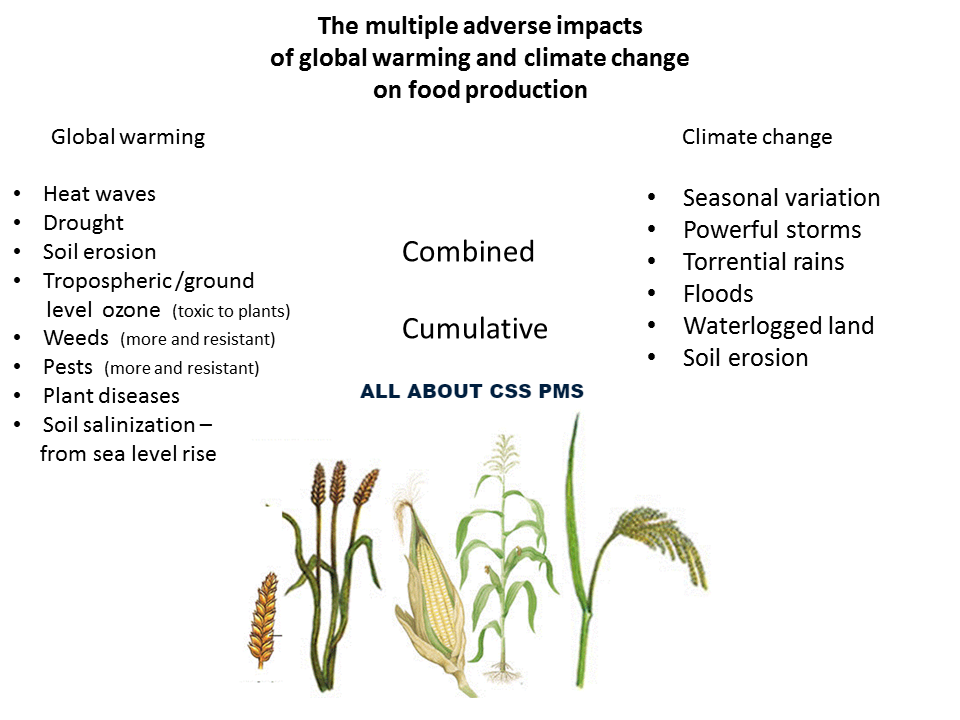
- Since the industrial revolution, humans have been changing the global climate by emitting huge amounts of greenhouse gases into the atmosphere, resulting in higher global temperatures, affecting hydrological regimes and increasing climatic variability.
- Climate change is projected to have significant impacts on agricultural conditions, food supply, and food security. Some of these effects are biophysical, some are ecological, and some are economic, including:
- A shift in climate and agricultural zones towards the poles.
- Changes in production patterns due to higher temperatures.
- A boost in agricultural productivity due to increased carbon dioxide in the atmosphere.
- Changing precipitation patterns.
- Increased vulnerability of the landless and the poor.
What is the Paris Agreement ?
The Paris Agreement is a landmark environment accord that was adopted by nearly every nation in 2015 to address climate change and its negative impacts. The aims to substantially reduce global greenhouse gas emissions in an effort to limit the global temperature increase in this century to 2 degrees Celsius above preindustrial levels, while pursuing means to limit the increase to 1.5 degrees. The agreement includes commitments from all major emitting countries to cut their climate-altering pollution and to strengthen those commitments over time. That pact provides a pathway for developed nations to assist developing nations in their climate mitigation and adaptation efforts, and it creates a framework for the transparent monitoring, reporting, and ratcheting up of countries' individual and collective climate goals.
History of the Paris Agreement :
Hammered out over two weeks in Paris during the United Nations Framework Convention on Climate Change's (UNFCCC) 21st Conference of Parties (COP21) and adopted on December 12, 2015, the Paris Agreement marked an historic turning point for global climate action, as world leaders representing 195 nations came to a consensus on an accord that has commitments from all countries aimed at combating climate change and adapting to its impacts.
President Obama was able to formally enter the United States into the agreement under international law through executive action, since it imposed no new legal obligations on the country. The United States has a number of tools already on the books, under laws already passed by Congress, to cut carbon pollution. The country formally joined the agreement in September 2016 after submitting its proposal for participation. The Paris Agreement could not take effect until at least 55 nations representing at least 55 percent of global emissions had formally joined. This happened on October5, 2016, and the agreement went into force 30 days later on November 4, 2016.
How Many Countries Are in the Paris Agreement ?
As of September 2019, 194 countries - every nation on earth, with the last signatory being war-torn Syria - have adopted the Paris Agreement. Of those, 179 have solidified their climate proposals with formal approval - including the United States, for now. The only major emitting countries that have yet to formally join the agreement are Russia, Turkey and Iran.
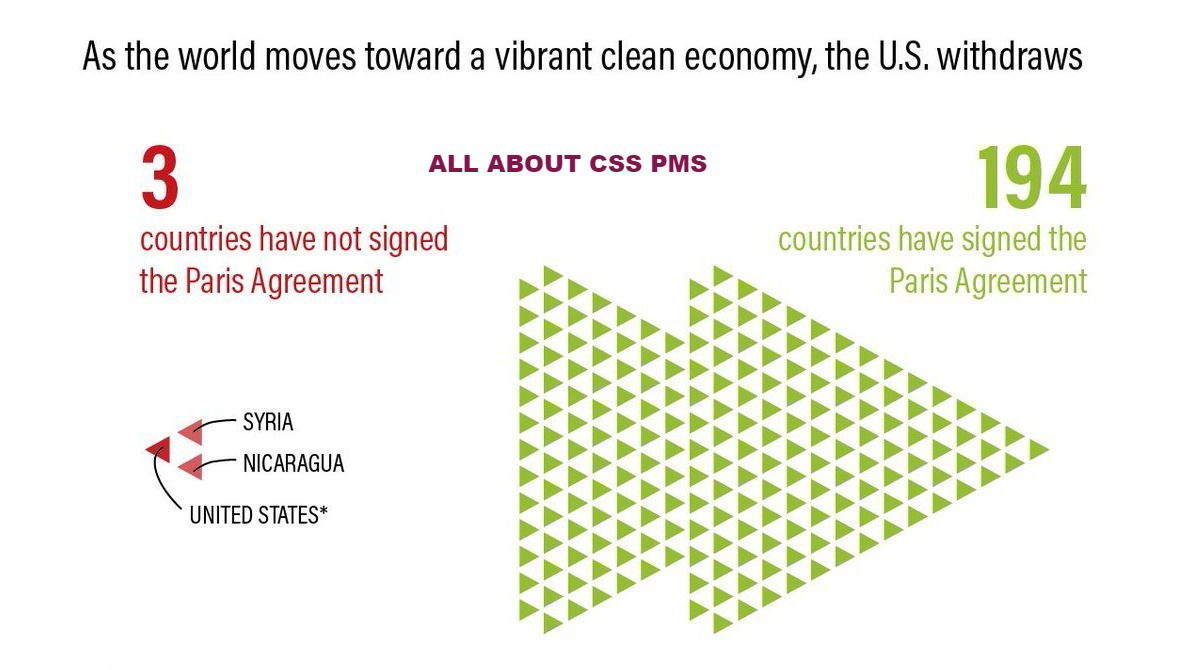
When did it come into Force ?
The Paris Agreement came into effect on November 4th, 2016, after the minimum threshold was met - 55 countries representing at least 55% of global emissions.
For countries that join after this point, the Agreement comes into force 30 days after the country "deposits its instrument of ratification, acceptance, approval or accession with the Secretary-General."
The COP23 meeting in Bonn hopes to create a road map towards achieving the goals of the Agreement and combat global warming.
What Happens if a Party Changes its Mind?
The United States announced in June that it intended to withdraw from the Paris Agreement. However, once a party has joined the agreement, they cannot begin the process of withdrawal for three years. There is no financial penalty for leaving, but with Syria's announcement it will leave the US as the only nation not party to the agreement.
The Paris Agreement signifies years of work in trying to combat climate change. In 1992, countries joined an international treaty, the United Nations Framework Convention on Climate Change. In 2005, the Kyoto Protocol became a legally binding treaty. It committed its parties to internationally binding emission reduction targets. It ends in 2020, and COP21 is designed to take its place.
The Paris Agreement and Trump :
Following through on a campaign promise, Trump - a climate denier who has claimed climate change is a "hoax" perpetuated by China - announced in June 2017 his intent to withdraw the United States from the Paris Agreement.

Yet notwithstanding the president's declaration from the Rose Garden that "We're getting out," it's process for withdrawing requires that the agreement be in force for the agreement be in force for three years before any country can formally announce its intention to drop out. then it has to wait a year before actually leaving the pact. This means the earliest the United States could officially exit is November 4, 2020 - a day after presidential election. Even a formal withdrawal wouldn't necessarily be permanent, experts say; a future president could rejoin in as short as a month's time.
Since Trump's announcement, U.S. envoys have continued to participate - as mandated - in U.N. climate negotiations to solidify details of the agreement. Meanwhile, thousands of leaders nationwide have stepped in to fill the void created by the lack of federal climate leadership, reflecting the will of the vast majority of Americans who support the Paris Agreement. Among city and state officials, businesses leaders, universities, and private citizens, there has been groundswell of participation in initiatives such as America's Pledge, the United States Climate Alliance, We are still in, and the American Cities Climate Challenge. The complementary and sometimes overlapping movements aim to deepen and accelerate efforts to tackle climate change at the local, regional, and national levels. Each of these efforts is focused on keeping the United States working toward the goals of the Paris Agreement despite the attempts by Trump to take the country in the opposite direction.
The key points of the Paris Agreement ;
Keeping Temperature Rises Below 1.5°C :
Governments have agreed to "pursue efforts" to limit warming to 1.5°C above pre-industrial levels:
something that would have seemed unthinkable just a few months ago. There is a scientific rationale for the number. John Schellnhuber, a scientist who advises Germany and the Vatican, says 1.5°C marks the point where there is a real danger of serious "tipping points" in the world's climate. The goal of 1.5°C is a big leap below the 2°C that nearly 200 countries agreed as a limit six years ago in Copenhagen. but bear in mind we've already hit 1°C, and recent data shows no sign of a major fall in the global emissions driving the warming. As many of the green groups here in Paris note, the 1.5°C aspiration meaningless if there aren't measures for hitting it.
Pledges to Curb Emissions :
Before the conference started, more than 180 countries had submitted pledges to cut or curb their carbon emissions (intended nationally defined contributions, or INDCs, in the UN jargon). These are not sufficient to prevent global temperatures from rising beyond 2°C- in fact it is thought they will lead to a 2.7°C rise or higher.

Long Term Global Goal for Net Zero Emissions :
Countries have promised to try to bring global emissions down from peak levels as soon as possible. More significantly, they pledged "to achieve a balance between anthropogenic emissions by sources and removals by sinks of greenhouse gases in the second half of this century". Experts say, in plain English, that means getting to "net zero emissions" between 2050 and 2100. The UN's climate science panel says net zero emissions must happen by 2070 to avoid dangerous warming.
Take Stock Every Five Years :
187 countries have put forward their plans for how to cut and curb their emissions beyond 2020, as far out as 2030. But those pledges are not enough to keep warming below 2°C, beyond which climate change is expected to have catastrophic impacts. According to several analyses, the plans will see around 2.7-3°C.
That's why the text has a review mechanism to ramp up those pledges every five years, in order to make them strong enough to keep under 2°C. The first stocktake will happen in 2018, but the first one under the deal happens in 2023. The text promises that parties "shall undertake the first global stocktake in 2023 and every five years."
Loss and Damage :
The deal includes loss and damage, a mechanism for addressing the financial losses vulnerable countries face from climate impacts such as extreme weather. But it also includes a clause that will keep the US happy- that it won't face financial claims from vulnerable countries hit by climate change: "It does not involve or provide a basis for any liability or compensation".
Money :
Finance to help developing countries adapt to climate change and transition to clean energy was an important sticking point in the negotiations. This part of the deal has been moved into the non-legally binding. A sop to the US, which knows it would not be able to get such a pledge of cash past the Republican-controlled Senate. The draft text says that the countries "intend to continue their existing collective mobilization goal through 2025". That means the flow of $100bn (£66bn) a year will continue beyond 2020. By 2025 the draft agreement undertakes to improve on that "from a floor of $100bn".